Here we are providing Class 12 Biology Important Extra Questions and Answers Chapter 16 Environmental Issues. Important Questions for Class 12 Biology are the best resource for students which helps in Class 12 board exams.
Class 12 Biology Chapter 16 Important Extra Questions Environmental Issues
Environmental Issues Important Extra Questions Very Short Answer Type
Question 1.
What are pollutants?
Answer:
The substances causing pollution are termed pollutants.
Question 2.
What is the source of aerosols?
Answer:
Smoke, ash, soot.
Question 3.
What photochemical oxidants pollute the air?
Answer:
Peroxyacetyl nitrate, ozone, and aldehyde.
Question 4.
The use of lead-free petrol or diesel is recommended to reduce the pollutants emitted by automobiles. What role does leadership play?
Answer:
Lead inactivates the catalytic converter.
Question 5.
In which year was the Air (Prevention and Control of Pollution) Act amended to include noise as an air pollutant?
Answer:
In 1987.
Question 6.
Name the city in our country where the entire public road transport runs on CNG.
Answer:
Delhi.
Question 7.
It is a common practice to undertake desilting of overhead water tanks. What is the possible source of silt that gets deposited in the water tanks?
Answer:
The soil particles carried by water from a source of the water supply.
Question 8.
What is cultural eutrophication?
Answer:
Faster aging of a lake due to the presence of large amounts of industrial, agricultural wastes, and domestic sewage produced by human activities is called cultural or accelerated eutrophication.
Question 9.
List any two adverse effects of particulate matter on human health.
Answer:
- Breathing and respiratory problems like bronchitis, asthma, inflammation of lungs, etc.
- Cardiovascular disorders and premature death.
Question 10.
Why are tall chimneys recommended for factories?
Answer:
To reduce air pollution at ground level.
Question 11.
Name the biggest source of air pollution in large cities.
Answer:
Automobiles.
Question 12.
Why is CNG better than diesel? (CBSE Outside Delhi 2016)
Answer:
CNG burns most efficiently in automobiles and very little of it is left unburnt. It is cheaper and cannot be easily adulterated.
Question 13.
What is the frequency of infrasound and ultrasound?
Answer:
- Infrasound below 50 Hz.
- Ultrasound-Above 20000 Hz.
Question 14.
Name the layer of atmosphere that is associated with ‘good ozone’.(CBSE 2019)
Answer:
Stratosphere
Question 15.
What would have been the temperature at the surface of the earth without the greenhouse effect? (HOTS)
Answer:
18°C as compared to the present average of 15°C.
Question 16.
How much average global temperature will rise by the year 2100?
Answer:
1.4 – 5.8°C.
Question 17.
What are Dobson units? (CBSE Delhi 2011)
Answer:
Dobson units (DU) measure the thickness of ozone in a column of air from the ground to the top of the atmosphere.
Question 18.
Explain polar vortex.
Answer:
Antarctic air is completely isolated from the rest of the world by the natural circulation of wind called the polar vortex.
Question 19.
Name the world’s most problematic aquatic weed. What is the nature of the water body in which the weeds grow abundantly? (CBSE Delhi 2008)
Answer:
- Eichhornia
- Highly polluted freshwater bodies containing organic waste.
Question 20.
Write the name of the organism that is referred to as ‘Terror of Bengal’. (CBSE Delhi 2014)
Answer:
Eichhornia (Water hyacinth).
Question 21.
State the cause of Accelerated Eutrophication. (CBSE Delhi 2014)
Answer:
Nutrient enrichment due to the addition of pollutants from industries and homes into water bodies causes accelerated eutrophication.
Environmental Issues Important Extra Questions Short Answer Type
Question 1.
An electrostatic precipitator in a thermal power plant is not able to generate a high voltage of several thousand. Write the ecological implication because of it. (CBSE 2017)
Answer:
It will not be able to remove particulate matter present in the exhaust of thermal power plants. Hence it cannot control pollution as dust particles will be released into the air.
Question 2.
List four benefits to human life by eliminating the use of CFCs. Suggest two practices giving one example of each that helps protects rare or threatened species. (CBSE 2017)
Answer:
Benefits to human life by eliminating the use of CFCs:
- Ozone depletion will be prevented.
- The greenhouse effect will be controlled.
- Global warming will be controlled.
- It will prevent old climatic changes that take place due to a rise in temperature.
Two practices that help, protect rare or threatened species are:
- Ex-situ conservation: In this, organisms are taken out of their natural habitat and kept at a special care location. Example: Botanical garden, zoo, etc.
- In situ conservation: Here the species are conserved in their natural habitat. Example: Natural park, sanctuaries.
Question 3.
Why are microbes like Spirulina being produced on a commercial scale? Mention its two advantages. (CBSE Delhi 2018C)
Answer:
Spirulina is produced on a commercial scale due to the following reasons:
- Spirulina is a rich source of protein. It can be used to solve the problem of hunger and malnutrition.
- It also reduces environmental pollution as it utilizes the waste as raw material which otherwise pollutes the environment.
Question 4.
Classify pollution on the basis of origin.
Answer:
Types of pollution on the basis of origin:
- Natural, e.g. volcanic eruption.
- Anthropogenic, e.g. man-made such as industrial pollution.
Question 5.
What are the two main sources of air pollution?
Answer:
- Fixed sources: Which include large factories, electrical power plants, mineral smelters, small industries.
- Mobile sources: They include all sorts of transports.
Question 6.
What are the effects of carbon monoxide?
Answer:
Carbon monoxide (CO) is a product of the incomplete combustion of fossil fuels. Nearly 50% of all CO emission originates from automobiles. It is also present in cigarette smoke. CO is short-lived in the atmosphere and gets oxidized to CO2. Carbon monoxide is highly poisonous to most animals. When inhaled, CO reduces the oxygen-carrying capacity of the blood.
Question 7.
Write the names of four main gases which pollute the air.
Answer:
C02, CO, N02, and S02 pollute the air.
Question 8.
Differentiate between primary air pollutants and secondary air pollutants.
Answer:
Differences between primary air pollutants and secondary air pollutants:
| Primary air pollutant | Secondary air pollutant |
| 1. Pollutant persists in the form in which it is released in the environment. | 1. It is formed from another pollutant due to change or reaction. |
| 2. Example. Glass, D.D.T., Carbon monoxide, Nitrogen oxide, Hydrocarbons. | 2. Example. Ozone, Peroxyacyl nitrate (PAN) |
Question 9.
What are the effects of air pollution? How can it be minimized?
Answer:
Effects of air pollution: Atmospheric pollution causes respiratory and vascular diseases in humans, produces fluorosis in livestock, adversely affects plants and buildings, and poses a threat to the climate.
Control of air pollution: Air pollution can be minimized by separating pollutants from harmless gases, or by converting them to harmless substances before releasing the industrial and motor vehicle exhausts into the atmosphere.
Question 10.
What is particulate matter? How does particulate matter affect the biological world?
Answer:
Suspended Particulate Matter (SPM): The solid particles or liquid droplets (aerosols) remain suspended in the air. For example, smoke, soot, dust, asbestos, etc. SPM above the size of 10 mm is trapped by nasal hair, pharyngeal, tracheal, and bronchial mucus. The same is coughed out or deposited in the nose as nasal scales. Smaller particles of SPM reach the alveoli.
There they may be attacked by phagocytes or pass into living cells. SPM causes irritation in the respiratory tract, bronchitis, and lung diseases. These particles may cause asbestosis, pneumoconiosis, etc. They also result in reduced visibility.
Question 11.
What is photochemical smog? How smog affects the biological world?
Answer:
1. Photochemical Smog: It is a secondary pollutant. It is yellowish-brown smog that is formed under oxidizing conditions and high temperatures over cities and towns that are releasing a lot of nitrogen oxides and unburnt hydrocarbons. In still air, the two interact photochemically to produce photochemical oxidants-ozone, PAN, aldehydes, and phenols. Photochemical smog does not have any appreciable amount of primary pollutants. It is also called Los Angeles smog.
2. Effect on the biological world: It causes bleaching of foliage of certain plants. It also causes silvering, glazing, and necrosis of the leaves. It causes respiratory problems in animals.
Question 12.
What is acid rain? What are its effects on plants?
Answer:
Acid rains: Sulphur dioxide and sulfur trioxide are produced by the oxidation of sulfur in fossil fuels. Similarly, nitrogen dioxide or nitrogen monoxide are released through vehicular emissions. These gases react with water and form sulphuric acid, sulfurous acid, or nitric acid. These acids when precipitated as rain or snow create acid rain or acid precipitation. The pH of acid rain is less than 5-6 and could be as low as 4. Acid rain adversely affects plant vegetation by causing chlorosis and necrosis.
Question 13.
Write the effects of hydrocarbons (HCs).
Answer:
Effects of hydrocarbons:
- Benzene and its derivatives are carcinogens.
- Formaldehyde causes indoor pollution. It contributes to photochemical smog. Inhaling formaldehyde can cause respiratory irritation.
- Some reactive HCs contribute to the formation of secondary pollutants.
Question 14.
What is the relation between epiphytic lichen and air pollution?
Answer:
Epiphytic lichens are reliable indicators of air pollution and can often be ranked on a sensitivity scale to estimate changing level of atmospheric pollution, especially of S02. The presence or absence of certain epiphytic lichens in a given locality and the pattern of their distribution can be related to the extent of pollution in the area.
Question 15.
How is air pollution responsible for changing the ill effects of ultraviolet radiation?
Answer:
Air pollution is enhancing the ill effects of UV radiation. Fluorocarbons are threatening and depleting the ozone layer of the stratosphere, thus allowing the UV radiations to reach this planet. The UV radiations cause serious damages to life by damaging nucleic acids in living organisms.
Question 16.
Mention any two examples of plants used as windbreakers in the agricultural fields.
Answer:
Windbreakers or shelterbelts provide shelter from wind and protect soil from erosion. Jamun and Imli and some other trees like Babul, Lawsonia, Thevetia, and Calotropis act as windbreakers in the agricultural field.
Question 17.
It is true that carpets and curtains/drapes placed on the floor or wall surfaces can reduce the noise levels. Explain briefly.
Answer:
Yes, it is true that placing carpets on the floor and curtains on the wall surface, windows, reduce the noise level. This is because the curtains and carpets on the wall surface act as muffling devices and absorb sounds of moderate level.
Question 18.
What is hybrid vehicle technology? Explain its advantages with a suitable example.
Answer:
The technology used to run vehicles on dual-mode like petrol or compressed natural gas is said to be hybrid vehicle technology. These vehicles run on either petrol or CNG. As CNG is a clean and green fuel so it is helpful to reduce environmental pollution and also to conserve petrol and other fossil fuels.
Question 19.
Is it true that if the dissolved oxygen level drops to zero the water will become septic? Give an example that could lower the dissolved oxygen content of an aquatic body.
Answer:
Yes, the water becomes septic if the dissolved oxygen drops to zero. Organic pollution (biodegradable) is an example.
Question 20.
Name any one of the greenhouse gases and their possible source of production on a large scale. What is the harmful effect of it?
Answer:
C02 and Methane. C02 levels are increasing due to the burning of fossil fuels leading to global warming.
Question 21.
It is a common practice to plant trees and shrubs near the boundary walls of buildings. What purpose do they serve?
Answer:
The plants growing near the boundary wall act as barriers to sound pollution and act as dust catchers.
Question 22.
Why has the National Forest Commission of India recommended a relatively larger forest cover for hills than the plains?
Answer:
National Forest Commission in its National Forest Policy (1988) has recommended 33 percent forest cover for the plains and 67 percent for the hills because plains mainly provide land for human settlements. Forests on the hills prevent soil erosion and landslides.
Question 23.
How can slash and burn agriculture become environment-friendly?
Answer:
Slash and burn agriculture can become environment-friendly if rows of trees and shrubs are left intact while clearing the area for cultivation. This will prevent soil erosion and the invasion of weeds. There will be a quicker recovery of the forest after the area is abandoned.
Question 24.
What is the main idea behind the “Joint Forest Management Concept” introduced by the Government of India?
Answer:
It is government-private entrepreneurship for upkeeping forests. The forest department prepares the plan, procures saplings and equipment for planting and plant protection. The locals take care of the plants till they become mature. For this, they get an honorarium and share in plant products. This sort of management provides livelihood to locals and protection to plants against stealing and illegal felling of trees.
Question 25.
What do you understand by snow blindness?
Answer:
Snow blindness is temporary blindness caused by inflammation of the cornea due to absorption of UV-B radiations. It is accompanied by photo burning and dimming of eyesight after which cataract develops. Regular exposure to UV-B radiations causes permanent damage to the cornea resulting in blindness.
Question 26.
What is water pollution?
Answer:
Water pollution: The addition of harmful materials to water is termed water pollution. The sources of inland water pollution are community wastewater (sewage) and wastes from industries and agricultural practices. Water pollutants include organic matter, pathogens, chemicals and minerals, solid particles, radioactive wastes, and heat.
Question 27.
What are two serious problems with the use of nuclear energy?
Answer:
Nuclear energy has two most serious problems:
- The accidental leakage of radioactivity
- The safe disposal of radioactive wastes.
Question 28.
Particulate and gaseous pollutants along with harmless gases are released from the thermal power plants.
(i) Name any two harmless gases released.
Answer:
Nitrogen and oxygen.
(ii) Name the most widely used device for removing particulate pollutants from the air. Explain how the device is used? (CBSE 2009)
Answer:
Electrostatic precipitator: Working of electrostatic precipitator The device has electrode wires kept at very high voltage in order to produce corona that releases electrons. These electrons provide dust particles a negative charge. The device has a collecting plate that is grounded. So when air with dust rushes through the device, the negatively charged dust is trapped at the collecting plate.
Question 29.
Study the graph given below and answer the questions that follow:
(i) What is the relationship between dissolved oxygen and biochemical oxygen demand (BOD)?
(ii) Mention their effect on aquatic life in the river. (CBSE 2008)
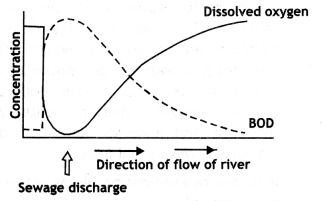
Answer:
(i) BOD indicates the quantity of wastewater. BOD refers to the amount of dissolved oxygen required by bacteria in decomposing oxygen.
Thus greater the BOD, the lesser will be dissolved oxygen. A sudden decline in dissolved oxygen causes the death of many aquatic organisms.
(ii) There is a sharp decline in the dissolved organic waste downstream from the point of discharge. More the dissolved oxygen, the healthier will be the aquatic life and vice versa.
Question 30.
A crane had a DDT level of 5 ppm in its body. What would happen to the population of such birds? Explain giving reasons. (CBSE 2009)
Answer:
- Fish-eating bird crane has a DDT level of 5 ppm due to biomagnification.
- The high concentration of DDT disturbs calcium metabolism in birds.
- It causes thinning of eggshells and premature breaking of the egg.
- There will be a decline in the bird population.
Question 31.
Study the graph given below. Explain how is oxygen concentration affected in the river when the sewage is discharged into it. (CBSE Delhi 2011)
Answer:
The figure shows the changes as a result of sewage discharged into the river. Micro-organisms involved in the biodegradation of organic matter in the receiving water body consume a lot of oxygen. As a result, there is a sharp decline in dissolved oxygen downstream. It causes the death of a large number of fishes and other aquatic creatures.
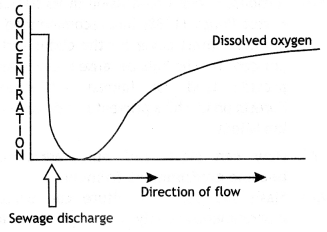
Question 32.
“Determination of Biochemical Oxygen Demand (BOD) can help in suggesting the quality of a water body” Explain. (CBSE Delhi 2015)
Answer:
The quality of the water body depends upon the organic wastes present in it. More is the amount of organic wastes present, poorer is the quality of water body for human consumption. The number of organic wastes can be determined by the BOD of that water body, e.g. BOD of pure drinking water is less than one, below 1500 mg/liter for weak organic wastewater but is more than 4000 mg/liter for a highly polluted water body.
Question 33.
Discuss the role of women and communities in the protection and conservation of forests.
Answer:
Role of women and communities in the protection and conservation of forests:
- In 1731, the Bishnoi community led by a woman Amrita Devi obstructed the cutting of trees by hugging the tree and asked the workers of the king to cut her before cutting the tree. Her three daughters and hundreds of other Bishnois lost their lives in saving trees.
- Chipko movement started by Chandi Prasad Bhatt and Sunder Lai Bahuguna of Silyara in the Tehri region when workers of the contractor were not allowed to cut the trees by village people by hugging around them.
Question 34.
Explain the different steps involved during the primary treatment phase of sewage. (CBSE Delhi 2015)
Answer:
Primary treatment of wastewater in sewage treatment plants involves mechanisms like floatation, Alteration, and sedimentation so as to remove insoluble and stable solid wastes. The final product after primary treatment is called primary sludge.
Question 35.
How have human activities caused desertification? Explain. (CBSE Delhi 2013)
Answer:
Desertification caused by human activities. The development of the fertile topsoil takes centuries. But it can be removed very easily due to human activities.
- Over-cultivation
- Unrestricted grazing
- Deforestation
- Poor irrigation practices.
All these human activities result in arid patches on land. When large barren patches extend and meet over time a desert is created.
Thus desertification is a major problem particularly due to increased urbanization.
Environmental Issues Important Extra Questions Long Answer Type
Question 1.
Define pollution. Compare the biodegradable and non-biodegradable pollutants.
Answer:
Pollution: “Environmental pollution is an unfavorable alteration of our surroundings largely as a by-product of man’s actions through direct or indirect effects of changes in energy patterns, radiation levels, chemical and physical conditions and abundance of organisms.”
Differences between biodegradable and non-biodegradable pollutants:
| Biodegradable Pollutants | Non-biodegradable Pollutants |
| 1. These wastes can be broken down into harmless substances naturally. | 1. These cannot be broken down into harmless substances naturally. |
| 2. The disposal of biodegradable wastes is easy and therefore, maintains balance in the ecosystem. Example. Cattle dung | 2. Their disposal is not easy and is a problem. Example. D.D.T., plastics. |
Question 2.
What is air pollution? List various air pollutants.
Answer:
Air pollution: The release of harmful materials into the air is called air or atmospheric pollution. It is the degradation of air quality and atmospheric conditions.
Air pollutants include gaseous materials, suspended particles, and radioactive substances.
1. The gaseous pollutants of the air come from combustion in motor vehicles and industries. These include CO, C02, NO, N02, S02, S03, hydrocarbons, fluorides, and photochemical oxidants such as peroxyacetyl nitrate (PAN), ozone (03), and aldehydes. PAN is a secondary pollutant formed in the air by the interaction between nitrogen oxides and hydrocarbons in the presence of sunlight. It is more toxic than the primary pollutants. An increase in toxicity by the reaction among pollutants is called synergism.
2. The particulate contaminants of air also come from industries and automobiles. These include fly-ash, soot, metal dust, cotton fibers, asbestos, fibers, lead, aerosols (chlorofluorocarbons or CFCs), polychlorinated biphenyls (PCBs), tobacco smoke, smog, pollen, spores, cysts, and bacteria.
(in) Radioactive substances released by nuclear explosions and war explosives are also very harmful air pollutants.
Question 3.
Define a pollutant. How many types of pollutants are there?
Answer:
Pollutant: It is a substance (e.g. dust, smoke), chemical (e.g. S02), or factor (e.g. heat, noise) that on release into the environment has an actual or potentially adverse effect on human interests. A pollutant can also be defined as a constituent in the wrong amount, at the wrong place, or at the wrong time.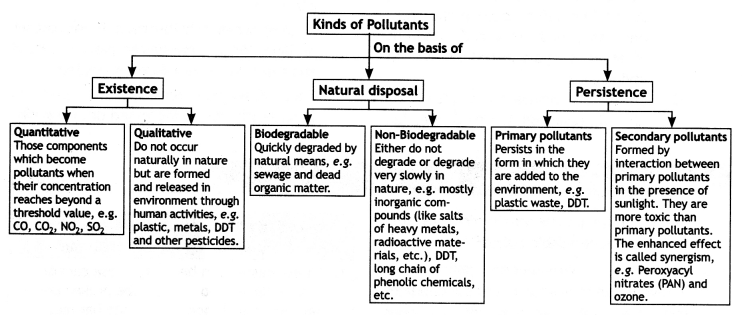
Question 4.
What measures do you suggest to control pollution from automobile exhaust?
Answer:
Control of pollution from automobile exhaust:
- Efficient engines can reduce the number of unburnt hydrocarbons from vehicuLar emissions.
- Use of cataLytic converters to convert harmful gases to harmless.
- Use of good quality fuel.
- Unleaded petroL can reduce the amount of lead in the exhaust.
- The use of CNG (compressed natural gas) Lowers the toxic contaminants in the exhaust.
Question 5.
Blends of polyblend and bitumen, when used, help to increase road life by a factor of three. What is the reason?
Answer:
Polyblend is a fine powder of recycled modified plastic. The binding property due to increased cohesion and enhanced water-repelling property of plastic makes the road last longer besides giving added strength to withstand more loads.
This is because:
- Plastic increases the melting point of the bitumen which would prevent it from melting in India’s hot and extremely humid climate, where temperature frequently crosses 45°C.
- Rainwater will not seep through because of the plastic in the tar.
Question 6.
“Indiscriminate human activities have strengthened the greenhouse effect resulting in Global Warming.” Give the relative contribution of various Greenhouse Gases in the form of a pie chart and explain the rate of the energy of sunlight reaching the earth’s surface contributing towards Global Warming. (CBSE Sample Paper 2020)
Answer:
a)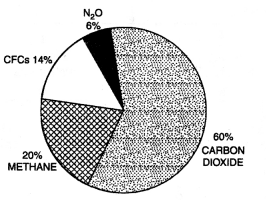
(b) Rate of the energy of sunlight:
- Clouds and gases reflect one-fourth of incoming solar radiations.
- Some of the energy is absorbed by clouds and gases.
- Thus only half of the solar energy falls on the surface of the earth.
- The small amount of energy is reflected back.
- Earth surface re-emits heat in the form of infrared radiations.
- The major fraction of solar energy is absorbed by atmospheric gases.
Question 7.
How does a scrubber function?
Answer:
Scrubber: A scrubber can remove gases like sulfur dioxide. In a scrubber, the exhaust is passed through a spray of water or lime. Water dissolves gases and lime reacts with sulfur dioxide to form a precipitate of calcium sulfate or sulfite.
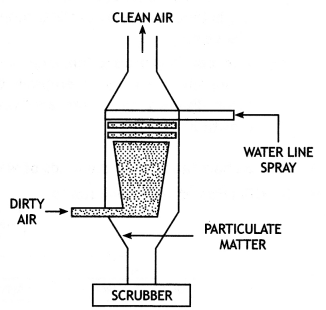
Question 8.
Discuss the causes and effects of global warming.
Answer:
Global warming: The increase in global mean temperature due to the enhanced greenhouse effect is called global warming.
Effects of global warming:
1. Effect on weather and climate.
(а) The average temperature of the earth may increase by 1.4° to 5.8°C by the year 2100.
(б) Winter precipitation may decrease at lower altitudes.
(c) Frequency of droughts, floods may increase.
(d) Climatic change is a threat to human health in tropical and subtropical countries.
2. Sea level change. Sea level had been raised by 1 to 2 mm per year during the 20th century. It is predicted that by the year 2100, the global mean sea level can increase up to 0.88 m over the 1990 level. Global warming may contribute to sea-level rise due to the thermal expansion of the ocean.
3. Effect on a range of species distribution. Vegetation may extend 250-600 km poleward with a global rise in temperature by 2 to 5°C during the 21st century.
4. Effect on food production. Increased temperature will cause an eruption of plant diseases and pests and vast growth of weeds.
Question 9.
Show the relative contribution of greenhouse gases to total global warming.
Answer:
Greenhouse gases:
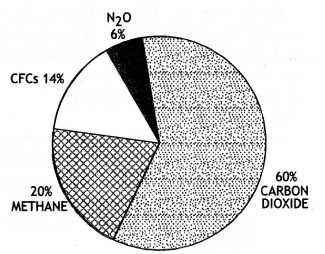
The relative contribution of various greenhouse gases to total Global warming.
Question 10.
Make a chart illustrating the kinds of water pollutants.
Answer:
Classification of water pollutants: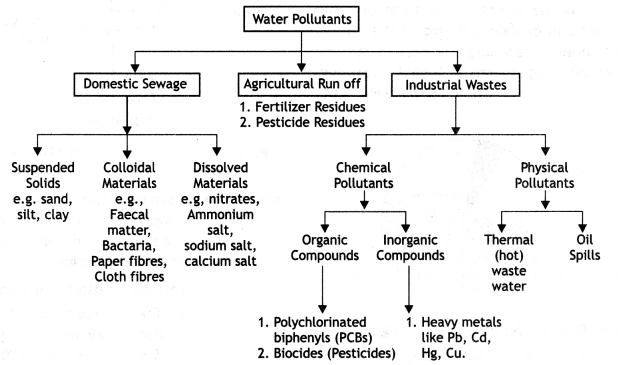
Question 11.
List four laws that enforce control of pollution.
Answer:
1. The Environment (Protection) Act, 1986: This act clearly brings the protection of air, water, and soil quality, and the control of environmental pollutants including noise under its purview.
2. The Insecticide Act, 1968: This act deals with the regulation of import, manufacture, sale, transport, distribution, and use of insecticides with a view to preventing risk to human health and other organisms.
3. The Water (Prevention and Control of Pollution) Act, 1974: This act deals with the preservation of water quality and the control of water pollution with a concern for the detrimental effects of water pollutants on human health and also on the biological world.
4. The Air (Prevention and Control of Pollution) Act, 1981: The act deals with the preservation of air quality and the control of air pollution with a concern for the detrimental effects of air pollutants on human health and also on the biological world. In 1987, important amendments of the Air Act 1981 were made and the noise was recognized as an air pollutant.
5. Many countries have enacted legislation to control noise. India enacted the Air (Prevention and Control of Pollution) Act, 1981 and as per this, noise pollution has been declared as an offense.
Question 12.
A factory drains its wastewater into the nearby lake causing algal bloom.
(i) How was the algal bloom caused?
Answer:
An algal bloom is caused due to enrichment of water with nutrients such as nitrogen and phosphorus. As fertility increases plant life increases.
(ii) What would be the consequences?
Answer:
Water becomes unfit for aquatic fauna because of scum and unpleasant odors. The fish and other organisms die because of a shortage of oxygen.
(iii) Name the phenomenon that caused it. (CBSE2008)
Answer:
Eutrophication.
Question 13.
Explain accelerated eutrophication. Mention any two consequences of this phenomenon. (CBSE 2009)
Answer:
Accelerated eutrophication: The natural aging of a lake by the biological enrichment of its water is called eutrophication. However, if pollutants from man’s activities like effluents from industries and homes radically accelerate the aging process, it is called accelerated cultural eutrophication.
Consequences:
- There is excess growth of algae causing algal bloom that gives an unpleasant odor.
- There is a shortage of oxygen which causes the death of the fauna of the water body.
- Ultimately death of the lake occurs.
Question 14.
How does algal bloom destroy the quality of a freshwater body? Explain. (CBSE Delhi 2013)
Answer:
Algal bloom destroys the quality of the freshwater body. Phosphorus and nitrates dissolved in polluted water act as nutrients for the green algal plants. These pollutants accelerate the growth of algae that may form a mat on the water surface. It is termed an algal bloom.
Effect:
- The algae use oxygen at night and deoxygenate the water enough to kill the fish and other aquatic animals.
- The algal mat on the water surface blocks light, making it unavailable for submerged plants.
- The algae and dead organisms feed the oxygen-consuming bacteria.
- Silt and decaying matters accumulate and finally fill the water body (lake or pond). This process is called senescence.
- It is a natural stage in the change of water body into dry land and it becomes barren. Ultimately death of the water body occurs.
Question 15.
How did a citizen group called Friends of Areata March, Areata, California, USA, help to improve the water quality of the marshland using Integrated Waste Water Treatment? Explain in four steps. (CBSE 2018)
Answer:
Wastewater including sewage can be treated in an integrated manner by utilizing a mix of artificial and natural processes, which are as follows:
- First of all the conventional sedimentation, filtering, and chlorine treatments are given. However, after this stage, a lot of dangerous pollutants like dissolved heavy metals still remain.
- To combat this, an innovative approach was taken. The biologists developed a series of six connected marshes over 60 hectares of marshland.
- Appropriate plants, algae, fungi, and bacteria were seeded into this area, which neutralizes, absorbs, and assimilates the pollutants. Hence, as the water flows through the marshes, it gets purified naturally.
- The marshes also constitute a sanctuary, with a high level of biodiversity in the form of fishes, animals, and birds.
Question 16.
List the control measures for minimizing air pollution.
Answer:
Control measures for minimizing air pollution:
- Simple combustible solid wastes should be burnt in incinerators.
- Automobiles must be either made to eliminate the use of gasoline and diesel oil or complete combustion is obtained in the engine so that harmful products are omitted.
- There should be a cut in the use of agricultural sprays.
- Excessive and undesirable burning of vegetation should be stopped.
- Smoking should be stopped.
- Use of electrostatic precipitators and filters in the factories to minimize atmospheric pollution.
- The use of tall chimneys can substantially reduce the concentration of pollutants at the ground level.
- Weather forecasts can help in controlling air pollution as the meteorological conditions affect the dispersion, dilution, and mixing of various emissions and proper operation of factory schedule, e.g. when atmospheric stagnation or calm is predicted, a power plant should switch over from coal to gas.
- Separation of pollutants from harmless gases.
- Dispersion of pollutants to innocuous (harmless) products before releasing into the atmosphere.
Question 17.
Why is the ozone layer in the stratosphere called a protective layer?
Answer:
Ozone layer as a protective layer: The ozone layer in the stratosphere is very useful to human beings because it absorbs the major part of harmful ultraviolet radiation coming from the sun. Therefore, it is called a protective layer. However, it has been observed that the ozone layer is getting depleted. One of the reasons for the depletion of the ozone layer is the action of aerosols spray propellants.
Chemicals such as fluorocarbons and chlorofluorocarbons are used as aerosol propellants. These compounds react with ozone gas in the atmosphere thereby depleting it. Scientists all over the world are worried about the destruction of the ozone layer. If the ozone layer in the atmosphere is significantly decreased, these harmful radiations would reach the earth and would cause many damages such as skin cancer, genetic disorders in man and other living forms. Efforts are being made to find substitutes for these chemicals that do not react with ozone.
Question 18.
Why industrial effluents are more difficult to manage than municipal sewage? Name a disease that is caused by heavy metal contamination.
Answer:
Industrial effluents released into water contain toxic substances, such as arsenic, cadmium, lead, zinc, copper, mercury, and cyanides, besides some salts, acids, and alkalies. All these materials can prove harmful to health. They may reach the human body. Minamata is a disease caused by heavy metal (Mercury) contaminated water.
Question 19.
What is deforestation? List the causes of deforestation.
Answer:
Deforestation: According to an estimate, almost 40% of forests have been lost in the tropics and 1% of forests in the temperate region. In India, at the beginning of the twentieth century, forests covered about 30% of land whereas, by the end of the century, it reduced to 19.4%. The National Forest Policy (1988) has recommended 33% forest cover for plains and 67% for hills.
Causes of Deforestation:
- Forests are converted into agricultural land to feed the growing human population.
- Forests are cleared for making homes and establishing industries.
- Trees are felled for timber, firewood, etc.
- Jhum cultivation in the north¬eastern states has contributed to deforestation.
Question 20.
List all the wastes that you generate, at home, school, or during your trips to other places that you could very easily reduce. Which would be difficult or rather impossible to reduce?
Answer:
List of wastes:
- Papers, clothes, polythene bags
- Disposable crockery
- Aluminum foil, cans
- Leftover of tiffins
- Wood
- Sewage
Wastes that can be reduced:
- Papers, clothes,
- Leftover of tiffins.
Wastes that cannot be reduced:
- Aluminum foil cans
- Disposable crockery
- Polythene bags
Question 21.
Why ozone hole form over Antarctica? How will enhanced UV radiations affect us?
Answer:
Ozone hole: During the period 1956-1970 the springtime O3 layer thickness above Antarctica varied from 280 to 325 Dobson unit. Thickness was sharply reduced to 225 DU in 1979 and 136 DU in 1985. Antarctic air is completely isolated from the rest of the world by the natural circulation of wind called the polar vortex. The decline in ozone layer thickness during that springtime is called ozone hole. It was first noted in 1985 over Antarctica.
Effects of UV radiation on humans:
- In humans, the increase in UV radiation increases the incidence of cancer (including melanoma).
- Reduces the functioning of the immune system.
- The cornea absorbs UV-B radiations, and a high dose of UV-B causes inflammation of the cornea called snow blindness, cataract, etc. Exposure may permanently damage the cornea and cause blindness.
Question 22.
Write critical notes on:
(i) Eutrophication
Answer:
Eutrophication: The process by which a body of water becomes barren either by natural means or by pollution, extensively rich in dissolved nutrients. It results in the increased primary productivity that often leads to seasonal deficiency in dissolved oxygen. Less dissolved oxygen ultimately affects aquatic life.
Algal bloom: Phosphorus and nitrates dissolved in water act as nutrients and accelerate the growth of algae that may form a mat on the water surface. It is termed algal bloom.
Effects: The algae use oxygen at night and may deoxygenate the water enough to kill the fish and other animals. The algal mat at the water surface may block light to the submerged plants. The algae may die and sink, and feed the oxygen-consuming bacteria. They may be pushed onto the shore by wind and decompose, releasing foul gases, such as hydrogen sulfide. Silt and decaying matter may accumulate and finally fill the lake or pond. This process is called senescence. It is a natural stage in the change of a lake into dry land and it becomes barren.
(ii) Biological magnification (CBSE 2015, 2019 C)
Answer:
Biological magnification: The phenomenon in which the harmful pollutants (such as pesticides) enter the food chain and get concentrated more and more at each successive trophic level of organisms is called biological magnification.
This phenomenon is well known for mercury and DDT. The figure given ahead shows the biomagnification of DDT in an aquatic food chain. Zooplankton (tiny floating animals in the food chain), accumulated modest levels of DDT. However, small fish, forming the next level of the food chain, must eat zooplankton several times their own weight, and thus they accumulated more DDT.
In this manner, the concentration of DDT magnified at successive trophic levels, starting with 0.003 ppb (ppb = parts per billion) in water it ultimately reached 25 ppm (ppm = parts per million) in fish-eating birds. High concentrations of DDT disturb calcium metabolism in birds, which causes thinning of eggshells and their premature breaking eventually causing a decline in the bird population.
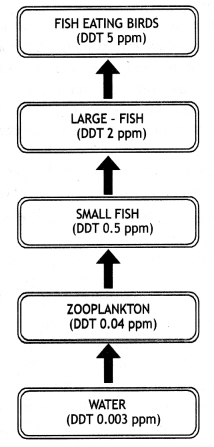
Biomagnification of DDT in an aquatic food chain.
(iii) Groundwater depletion and ways for its replenishment. (CBSE 2012)
Answer:
Groundwater depletion and ways for its replenishment: Underground water is most pure and safe for drinking. It is getting polluted particularly in industrial towns. The common sources of underground water pollution are sewage and industrial effluents spilled over the ground. The fertilizers and pesticides used in fields also act as pollutants. Pollution is also increased due to seepage from refuse dumps, septic tanks, and seepage pits. Method to control. Sewage and factory wastes should be treated to clean them before their release into water sources.
Question 23.
List various measures for control of noise pollution.
Answer:
Control of noise pollution:
- Construction of soundproof rooms for noisy machines in industries.
- Radios and transistors should be kept at low volume.
- The use of horns with jarring sounds should be banned.
- Noise-producing industries, aerodromes, railway stations, etc. should be shifted away from the inhabited areas.
- Proper laws should be enforced to check the misuse of loudspeakers and public announcement systems,
- Need to enforce a silence zone around institutions like educational institutes, residential areas, hospitals, etc.
- Sound-absorbing techniques like acoustical furnishing should be extensively employed.
- Noise should be deflected away from the receiver by using mechanical devices.
- The green muffler scheme involves growing green plants along roadsides to reduce noise pollution.
Question 24.
What measures, as an individual, you would take to reduce environmental pollution? (CBSE Delhi 2011)
Answer:
Role of individuals in reducing pollution:
- Use of unleaded petrol or CNG in vehicles as fuel.
- Use of reformulated gasoline to save ozone in the atmosphere.
- The use of power generators in residential areas should be avoided.
- Plantation of trees.
- Excessive and unplanned use of fertilizers should be avoided.
- Biodegradable material should be used.
- Do not blow the horn with a jarring sound.
- Radio, transistors, T.V., Music systems should be kept at low volume to control noise pollution.
Question 25.
Discuss briefly the following:
(i) Radioactive wastes
Answer:
(i) Radioactive wastes: Radioactive wastes are of three types depending on the amount of radioactivity.
(a) Low-level radioactive wastes.
(b) Intermediate level radioactive wastes.
(c) High-level radioactive wastes.
The use of nuclear energy has two most serious problems. The first is accidental leakage and the second is safe disposal of radioactive wastes. Wastes from atomic power plants come in the form of spent fuels of uranium and plutonium. People working in such power plants, nuclear reactors, fuel processors, etc. are vulnerable to their exposure. These also undergo biological magnification and may reach 75,000 times in birds.
Radioisotopes. Many radioactive isotopes like C14, I125, P32, and their compounds are used in scientific researches. The wastewater of these research centers contains radioactive elements which may reach human beings through water and food chains.
Disposal of radioactive wastes. Such wastes are first concentrated to reduce the volume and then kept for 50-100 years in small ponds within the premises of nuclear power plants. This interim storage causes considerable decay of radioactivity and lessening of heat problem. It has been recommended that subsequent storage should be done in suitably shielded containers buried within the rocks, about 500 m deep inside Earth. However, this method of disposal is meeting stiff opposition from the public.
(ii) Defunct ships and e-wastes.
Answer:
Defunct ships and e-wastes: Defunct ships are a kind of solid waste requiring proper disposal. Such ships are broken down in developing countries because of cheap labor and scrap metal. They often contain toxic substances such as asbestos, polychlorinated biphenyls, tributyltin, lead, and mercury.
Similarly, irreparable computers and electronic goods are known as electronic wastes of e-wastes. Most of them are shipped to developing countries for metals like copper, nickel, silicon, gold and are recovered by recycling. Recycling is the only solution for the treatment of such wastes, provided it is carried out in an environment-friendly manner. An international treaty called Basel Convention drafted in Basel (Switzerland) as a result of great demand from developing countries.
(iii) Municipal solid wastes.
Answer:
Municipal Solid Wastes: Solid wastes refer to everything that goes out in the trash. Municipal solid wastes are wastes from homes, offices, stores, schools, etc. that are collected and disposed of by the municipality. The municipal solid wastes generally comprise paper, food wastes, glass, metals, rubber, leather, textile, etc. Burning reduces the volume of the wastes, although it is generally not complete and open dumps often serve as the breeding ground for rats and flies.
Management of municipal solid wastes:
- Sanitary landfills were adopted as the substitute for open-burning dumps. In a sanitary landfill, wastes are dumped in a depression or trench after compaction and covered with dirt every day.
- Municipal solid wastes, containing biodegradable organic wastes, can be transformed into organic manure for agriculture.
- Sewage sludge and industrial solid wastes are used as landfills.
- Hazardous metal-containing wastes are used as bedding material for road construction.
- Other options are incineration of wastes and using emitted heat in electricity generation, and recycling various components of wastes.
Question 26.
What initiatives were taken for reducing vehicular air pollution in Delhi? Has the air quality improved in Delhi?
Or
Explain any three measures which will control vehicular air pollution in Indian cities. (CBSE 2009)
Answer:
Automobiles are the major sources of air pollution in Delhi because it has a very high number of cars.
Some specific measures taken to reduce vehicular air pollution are as follows.
- Use of CNG (Compressed Natural Gas) for its public transport system.
- Phasing out of old vehicles.
- Use of unleaded petrol.
- Use of low sulfur petrol and diesel.
- Use of catalytic converter in vehicles.
- Application of Euro II norms for vehicles.
Because of the above-mentioned steps taken up by the Government, the air quality of Delhi has improved with a substantial fall in carbon monoxide, oxides of sulfur, and nitrogen levels between 1997 and 2005.
Question 27.
Discuss briefly the following:
(i) Greenhouse effect
Answer:
Greenhouse effect: Earth’s temperature is maintained by reradiated infrared radiations by CO2, CH4, O3, NO, and N02 and slightly by water vapors in the atmosphere. These gases prevent heat from escaping to outer space, so are functionally comparable to glass panels of a greenhouse and are called greenhouse gases (GHGs) and phenomena called the greenhouse effect. The CO2 is added to the atmosphere mainly by burning fossil fuels, volcanic activities, etc.
Greenhouse gases are useful in keeping the earth warm with an average temperature of 15° C. In their absence, the surface temperature of the earth will be as low as 18° C. This temperature will freeze all water and kill most life. However, excess greenhouse gases are equally harmful. Over 7 × 1012 kg of CO2 is being added annually to the atmosphere by the burning of fossil fuels. As a result, the CO2 concentration of the atmosphere has risen from 0.028% in 1800 to .0359% in 1994. Now enhanced greenhouse effect is resulting in Global Warming.
(ii) Catalytic converters
Answer:
Catalytic converters: Catalytic converters, having expensive metals namely platinum-palladium and rhodium as catalysts, are fitted into automobiles for reducing the emission of harmful gases. As the exhaust passes through the catalytic converter, unburnt hydrocarbons are converted into carbon dioxide and water, and carbon monoxide and nitric oxide are changed to carbon dioxide and nitrogen gas, respectively. Motor vehicles equipped with catalytic converters should use unleaded petrol because leaded petrol inactivates the catalyst.
It has been established that the installation of catalytic converters can slash carbon monoxide emissions from 90 grams to 3.4 grams per mile run. So if half the vehicles on Delhi and Mumbai roads are made to install such catalytic converters, then total CO emission in India can be reduced by 70 percent.
(iii) Ultraviolet B
Answer:
Ultraviolet-B radiations: These are high energetic UV-radiations that are mostly blocked by the ozonosphere located in the stratosphere of the atmosphere. But due to the increased production of ozone-depleting substances (ODS) like CFCs, halons, etc., the ozone shield is becoming thinner and thinner. This is increasing the amount of UV-B radiations reaching the earth’s surface. These radiations are carcinogenic.
The cornea absorbs UV-B radiation. High dose of UV-B causes inflammation of the cornea called snow blindness cataract. Exposure may permanently damage the cornea.
Question 28.
Looking at the deteriorating air quality because of air pollution in many cities of the country, the citizens are very much worried and concerned about their health. The doctors have declared a health emergency in the cities where the air quality is very severely poor.
(i) Mention any two major causes of air pollution.
Answer:
Two causes of air pollution are:
(a) Burning of fossil fuels.
(b) Industrial effluents
(ii) Write the two harmful effects of air pollution on plants and humans.
Answer:
Harmful effects of air pollution are:
(a) It affects the respiratory system of humans and animals.
(b) It also reduces the growth and yield of crops and causes premature death of plants.
(iii) As a captain of your school Eco¬club, suggest any two programs you would plan to organize in the school so as to bring awareness among the students on how to check air pollution in and around the school. (CBSE2018)
Answer:
As a captain of your school Eco-club, I shall suggest:
(a) Encouraging public transport, i.e. buses, metro, etc and using CNG/electric vehicles instead of diesel and petrol vehicles.
(b) Planting more trees to curb pollution.
Question 29.
While studying pollution of water, a group of students observed mortality of fish in the river flowing through the city and also in the pond which was away from the city but was adjacent to the crop fields. They further found that drains of the city discharged sewage into the river and the water from farms flowed into the pond. Explain how these could be the cause of fish mortality. (CBSE Delhi 2019 C)
Answer:
- Pollutants from man’s activities cause eutrophication in ponds and rivers.
- The prime contaminants are nitrates and phosphate which act as plant nutrients.
- They overstimulate the growth of algae causing the formation of a thick layer of scum on the surface and an unpleasant odor.
- The dissolved oxygen in the water decreases. It is essential for all forms of aquatic life.
- At the same time, other pollutants flowing from farms into pond poison the whole population of fish.
- As the decomposition of dead fish occurs, the dissolved oxygen content of water further decreases.
- Ultimately pond chokes to death.
Question 30.
A young sperm whale, 33-foot long was found dead off the coast. It had a large amount of human trash like trash bags, polypropylene sacks, ropes, net segments, etc. amounting to 29 kilograms in its digestive system. The whale died because of inflammation of the abdominal lining. Analyze the possible reasons for such mishaps and suggest measures that can be taken to reduce such incidents. (CBSE Sample Paper 2018-19)
Answer:
- We are increasing the use of non-biodegradable products. In most of the products we buy, there is at least one layer of plastic in it.
- We have started packaging even our daily use products like milk and water in polybags.
- In cities, fruits and vegetables are packed in polystyrene and plastic packaging and we contribute heavily to environmental pollution.
- Most of the wastes are dumped in water bodies without segregation and treatment. One has to reduce the generation of non-biodegradable wastes and stop the irresponsible dumping of wastes into water bodies.